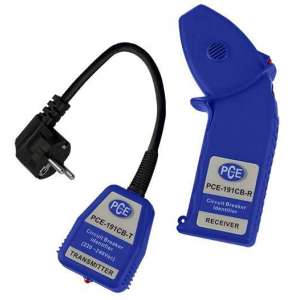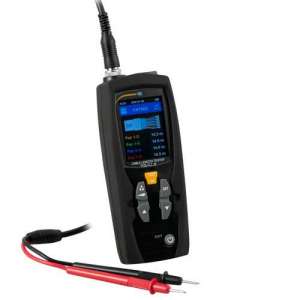Cable detectors
A cable detector, or cable tracer, is a device used to find wires hidden in walls, under the floor, or underground. Sometimes the cables break and, to repair or change them, it is necessary to know where they have been passed or where the breakage has occurred, being impossible to know with a simple examination from the surface.
If you know the route through which the cable passes and what you want to find is the exact place where the cable has broken (the distance from one end), there is a more precise technique that makes use of reflectometry, a diagnostic method based on the principle of radar. In this method a sounding signal is sent along the cable to be investigated and when it finds a discontinuity (impedance), a part of its energy is returned to the injection point, with the measurement of the return time in an oscilloscope it is known how far the cable is cut.
The cable detector can detect voltage lines and voltage-free lines. The cable detector can locate, cables, lines, circuits, short circuits and ground connections located on walls and floors. This makes the cable detector ideal for performing checks before drilling a wall to make sure there is no line. The cable detector consists of two individual devices, a receiver and a signal generator.
With one of the cable detector models you can locate pipes free of voltage and current, as well as with voltage and current in current circuits up to 300 V. The cable detector can locate cables, conduits, current circuits, short circuits and groundings, can check protective tubes and scan coaxial cables. For this it is not necessary to interrupt the current or disconnect electronic components of great sensitivity. They can operate in concrete, walls or earth intakes. There are some models of cable detector that also locates ferrous and non-ferrous metals, wood and even plastic with great precision.
Types
Issuance/Reception by contact:
Combination emitter/receiver by contact (then they cannot detect hidden electrical wires), they allow to identify the wires within a group, but only between ends (touching the conductor), for example, in a punch block.
Slightly more advanced cable detectors that incorporate a TDR, but their use is not very common and they are used only in environments with some specialization.
Electromagnetic field reception:
Simple electromagnetic field receivers that can detect hidden electrical wires, but only if they are connected to a phase and are close enough to the surface to be able to perceive the generated field. By not requiring a contact with the driver, they allow to detect, at a short distance, where a discontinuity occurs.
Combination emitter / receiver via radio so they can detect hidden electrical wires and, depending on the sensitivity of the receiver, can allow to capture the radiation either only near the surface or that emitted by buried wires at a certain depth. By not requiring a contact with the driver, they allow to detect, at a certain distance, where a discontinuity occurs.
Cable detector PCE-191 CB

Product Data Sheet:
Price:
€120.88 (inc. VAT)Detector de cables PCE-CLT 10

Product Data Sheet:
Price:
€302.38 (inc. VAT)



